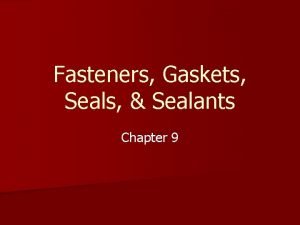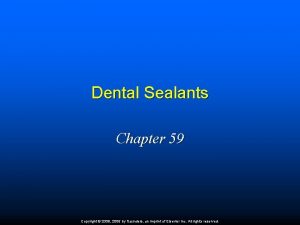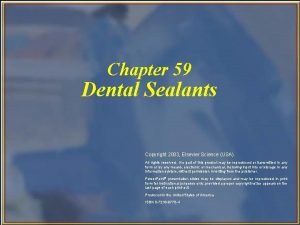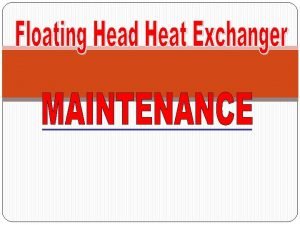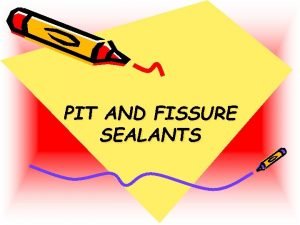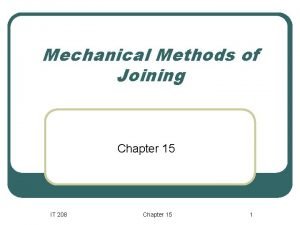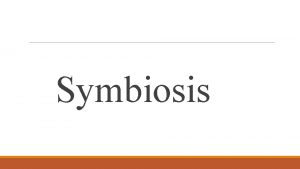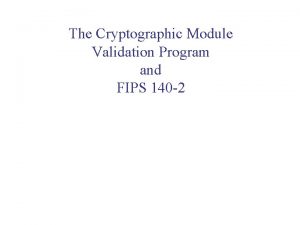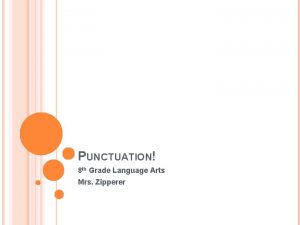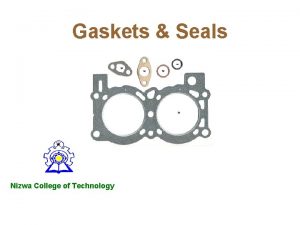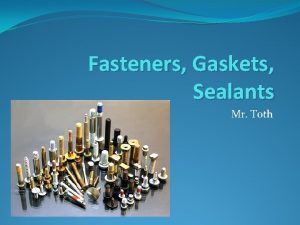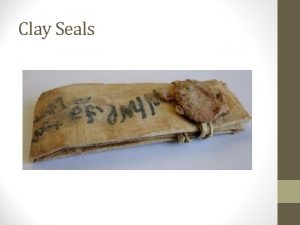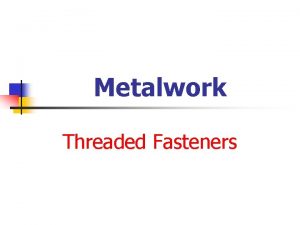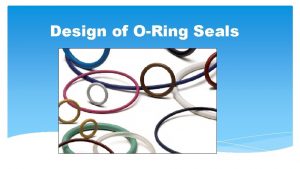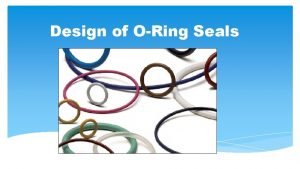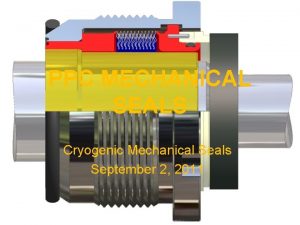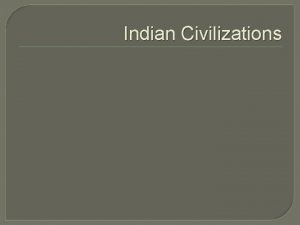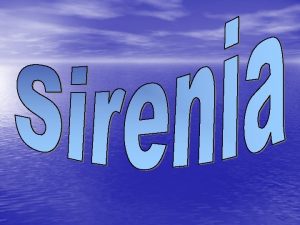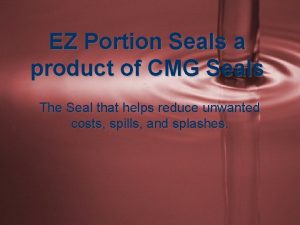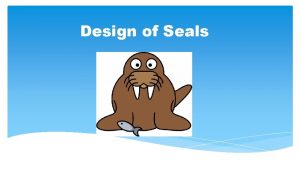Fasteners Gaskets Seals Sealants Chapter 9 Fasteners n















- Slides: 15

Fasteners, Gaskets, Seals, & Sealants Chapter 9

Fasteners n A fastener is a hardware device that mechanically joins or affixes two or more objects together. North American fastener production is strongly tied to the production of automobiles, aircraft, appliances, agricultural machinery, and other equipment.

Fasteners n Bolts - A (usually) metal fastener consisting of a cylindrical body, partially or completely threaded, and a larger head; it is inserted into an unthreaded hole (unlike a screw) up to the head, and a nut is threaded on the other end The size of bolts, etc. is determined by three dimensions. The first is the diameter of the bolt’s threads or the “bolt size". The second is the number of threads per inch or millimeter. The three primary thread classifications are: fine, course, and metric. The third is the length. The length is normally measured from the underside of the bolt head to the end of the threaded area. So, the bolt below is 5/16”-18 x 1. 50”

Fasteners n Bolts – Reverse Threads, or a reverse threaded bolt, are used from time to time when a normally threaded bolt or nut might work itself loose. All it means is that instead of turning it clockwise (righty) to tighten, you turn it counter-clockwise (lefty). To loosen a reverse threaded bolt, you turn it clockwise.

Fasteners n Bolts – The tensile strength is the maximum stress that a bolt can withstand without breaking. This is called the “GRADE” of the fastener. The stronger bolt required for the application the higher “GRADE” bolt is used.

Fasteners Cap n Serrated Nut - A nut is a type of hardware fastener with a threaded hole. Nuts are almost always used opposite a mating bolt to fasten a stack of parts together. The two partners are kept together by a combination of their threads' friction, a slight stretch of the bolt, and compression of the parts. Different types of nuts: Castle Nyloc Square Wing Acorn Flanged Barrel Lug Hex Tee Peanut Speed

Fasteners WASHERS q Flat Washer – Used under the head of a bolt or nut to distribute the forces applied when tightening. q Lock Washer – A washer that is not completely smooth or flat, designed to prevent a nut from loosening. q Serrated Washer – acts as an antivibration device to prevent the nut from loosening during rigorous service. q Fender Washer - Used under the head of a bolt or nut to distribute the forces applied when tightening.

Fasteners n Machine Screws - are similar to regular bolts but are usually smaller in diameter, are threaded all the way up to the head, and the head is often slotted.

Fasteners n Self-tapping screws - or thread cutting screws have sharp threads that cut into a material such as sheet metal or plastic.

Fasteners n Torque Specifications - Most automotive fasteners have specific tightening requirements. n Torque Sequence - The order in which a series of bolts or nuts should be tightened. This bolt-tightening-sequence is typically used to evenly tension large flat parts, such as oil pans, valve covers, or cylinder heads, to prevent the possible warping or distortion of the flat surface while it is being attached with the bolts. Step torque wrench up in increments: 20 - 40 - 56 foot-pounds, following the torque sequence at right. Note: Avoid swivel-joints which will cause the torque to be inaccurate. 1995 ACURA GS CYLINDER HEAD TIGHTENING SEQUENCE

Fasteners Removing Broken Fasteners q Method 1 – Use a stud extractor or vise grips and grab the protruding end and unscrew the broken fastener. q Method 2 – Drill a small hole down the center of the broken bolt and use a screw-extractor or easy out to remove the broken fastener. q Method 3 – Drill out the broken piece of fastener completely and re -tap new threads in the hole.

Gaskets and Seals n Gasket - A deformable material clamped between flat stationary surfaces to prevent the passage of fluids or gasses through an opening or joint. n Seal - A seal is a device which helps join systems or mechanisms together by preventing leakage (e. g. , in a fluid system), containing pressure, or excluding contamination. They are typically used around rotating shafts to provide a tight seal.

Sealers n Hardening Sealers – for use with n Non-Hardening Sealers - for use gasketing materials in low temperature and low pressure applications, such as hose connections, paper and cardboard gaskets on permanently mounted assemblies. with or without gasket materials to provide a seal between surfaces on semi-permanently mounted assemblies, such as water pumps, valve covers, and intake manifolds.

More Sealers n Anaerobic Sealers – Dry or cure without the presence of air. n RTV - Room temperature vulcanizer. RTV is a silicone glue that solidifies and stabilizes at room temperature n Form-In-Place – or “Gasket Makers” seal instantly, forming a reliable, long lasting elastomeric rubber gasket that outperforms precut gaskets and do away with the need for gaskets entirely.

QUESTIONS? Check the textbook chapter 9 for any questions you still need answered. n Check with at least three other students to try and find the answers you are missing. n Finally, Check with the instructor to learn where to go to find the answers you still need. n
 Automotive fasteners gaskets and sealants
Automotive fasteners gaskets and sealants Automotive fasteners gaskets and sealants
Automotive fasteners gaskets and sealants Chapter 59 dental sealants
Chapter 59 dental sealants Chapter 59 dental sealants
Chapter 59 dental sealants Chapter 59 dental sealants multiple choice
Chapter 59 dental sealants multiple choice Floating head heat exchanger for sale near me
Floating head heat exchanger for sale near me Concrete pipe gaskets
Concrete pipe gaskets Pit and fissure sealants definition
Pit and fissure sealants definition Types of sealants used in automotive
Types of sealants used in automotive Chapter 15 using fasteners
Chapter 15 using fasteners Fish thieves take rare seals’ prey
Fish thieves take rare seals’ prey Sog oil seal manufacturer
Sog oil seal manufacturer Heritage swim club
Heritage swim club Easter seals pei
Easter seals pei Fips 140 seals
Fips 140 seals Stop clubbing baby seals punctuation
Stop clubbing baby seals punctuation

